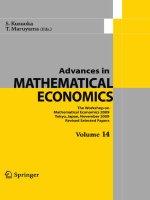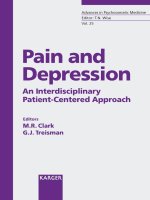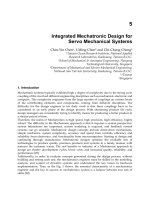- Trang chủ >>
- Khoa Học Tự Nhiên >>
- Vật lý
ADVANCES IN PHOTONIC CRYSTALS pptx
Bạn đang xem bản rút gọn của tài liệu. Xem và tải ngay bản đầy đủ của tài liệu tại đây (32.11 MB, 348 trang )
ADVANCES IN PHOTONIC
CRYSTALS
Edited by Vittorio M. N. Passaro
Advances in Photonic Crystals
/>Edited by Vittorio M. N. Passaro
Contributors
Luca Marseglia, Robinson Savarimuthu, Igor Guryev, Juan Ricardo Cabrera Esteves, Jose Amparo Andrade Lucio, Igor
A. Sukhoivanov, Oscar Ibarra Manzano, Everardo Vargas Rodriguez, Natalia Gurieva, Wenfu Zhang, Wei Zhao, Marcin
Koba, Volodymyr Fesenko, Sergiy Shulga, Tiziana Stomeo, Antonio Qualtieri, Ferruccio Pisanello, Luigi Martiradonna,
Pier Paolo Pompa, Marco Grande, Antonella D'Orazio, Massimo De Vittorio, Boris Malomed, Thawtachai
Mayteevarunyoo, Shunji Nojima, Zhiyuan Li, Lavrinenko, Vittorio M. N. Passaro
Published by InTech
Janeza Trdine 9, 51000 Rijeka, Croatia
Copyright © 2013 InTech
All chapters are Open Access distributed under the Creative Commons Attribution 3.0 license, which allows users to
download, copy and build upon published articles even for commercial purposes, as long as the author and publisher
are properly credited, which ensures maximum dissemination and a wider impact of our publications. After this work
has been published by InTech, authors have the right to republish it, in whole or part, in any publication of which they
are the author, and to make other personal use of the work. Any republication, referencing or personal use of the
work must explicitly identify the original source.
Notice
Statements and opinions expressed in the chapters are these of the individual contributors and not necessarily those
of the editors or publisher. No responsibility is accepted for the accuracy of information contained in the published
chapters. The publisher assumes no responsibility for any damage or injury to persons or property arising out of the
use of any materials, instructions, methods or ideas contained in the book.
Publishing Process Manager Ana Pantar
Technical Editor InTech DTP team
Cover InTech Design team
First published February, 2013
Printed in Croatia
A free online edition of this book is available at www.intechopen.com
Additional hard copies can be obtained from
Advances in Photonic Crystals, Edited by Vittorio M. N. Passaro
p. cm.
ISBN 978-953-51-0954-9
free online editions of InTech
Books and Journals can be found at
www.intechopen.com
Contents
Preface VII
Section 1 Theory 1
Chapter 1 Photonic Crystal Ring Resonator Based Optical Filters 3
S. Robinson and R. Nakkeeran
Chapter 2 Single and Coupled Nanobeam Cavities 27
Aliaksandra M. Ivinskaya, Andrei V. Lavrinenko, Dzmitry M. Shyroki
and Andrey A. Sukhorukov
Chapter 3 Birefringence in Photonic Crystal Structures: Toward
Ultracompact Wave Plates 51
Wenfu Zhang and Wei Zhao
Chapter 4 Propagation of Electromagnetic Waves in Anisotropic Photonic
Structures 79
V.I. Fesenko, I.A. Sukhoivanov, S.N. Shul’ga and J.A. Andrade Lucio
Chapter 5 Threshold Mode Structure of Square and Triangular Lattice
Gain and Index Coupled Photonic Crystal Lasers 107
Marcin Koba
Chapter 6 Two-Component Gap Solitons in Self-Defocusing Photonic
Crystals 137
Thawatchai Mayteevarunyoo, Athikom Roeksabutr and Boris A.
Malomed
Chapter 7 Very Long Photon-Lifetimes Achieved by Photonic Atolls 157
S. Nojima
Chapter 8 Dynamic Characteristics of Linear and Nonlinear Wideband
Photonic Crystal Filters 179
I. V. Guryev, J. R. Cabrera Esteves, I. A. Sukhoivanov, N. S. Gurieva, J.
A. Andrade Lucio, O. Ibarra-Manzano and E. Vargas Rodriguez
Section 2 Experiments and Applications 201
Chapter 9 Photonic Crystal Coupled to N-V Center in Diamond 203
Luca Marseglia
Chapter 10 Silicon Nitride Photonic Crystal Free-Standing Membranes: A
Flexible Platform for Visible Spectral Range Devices 221
T. Stomeo, A. Qualtieri, F. Pisanello, L. Martiradonna, P.P. Pompa, M.
Grande, D’Orazio and M. De Vittorio
Chapter 11 Photonic Crystals for Optical Sensing: A Review 241
Benedetto Troia, Antonia Paolicelli, Francesco De Leonardis and
Vittorio M. N. Passaro
Chapter 12 Silicon Photonic Crystals Towards Optical Integration 297
Zhi-Yuan Li, Chen Wang and Lin Gan
ContentsVI
Preface
After 1987 Yablonovitch's milestone paper, photonic crystals have been the topic of a huge num‐
ber of papers. For many years, photonic crystals have been investigated both theoretically and ex‐
perimentally because of their peculiar and intriguing properties for nanophotonic applications,
such as laser generation, optical sensing, beam filtering, anisotropic property control, high field
confinement, and so on. In particular, after the first demonstration of two-dimensional photonic
crystal at optical wavelengths, planar slabs have been investigated to efficiently fabricate two-di‐
mensional photonic crystals by etching the hosting slab or by forming pillars over the slab. To this
aim, several technologies have been applied to derive photonic crystal properties in hosting mate‐
rials, such as semiconductor slabs (III/V alloy compounds, silicon and compounds), metamateri‐
als and others, as well as in photonic crystal fibers. Nowadays, many international research
groups are still very active in this topic, since many theoretical aspects in modeling and design of
photonic crystals, as well as in fabrication aspects, are not yet well standardized.
This book presents some advances of the international research in the field, collecting many chap‐
ters relevant to different theoretical and experimental aspects of photonic crystals, mainly two-
dimensional, for Nanophotonics applications. Chapters are written by some important
international research groups. The book is divided in two parts, a theoretical section followed by
a section devoted to experiments and applications. First part includes chapters developing several
numerical methods for analysis and design of photonic crystal devices, such as 2D ring resonators
for filters, single and coupled nanobeam cavities, birefringence in photonic crystal cavities, propa‐
gation in anisotropic photonic crystals, threshold analysis in photonic crystal lasers, gap solitons
in photonic crystals, novel photonic atolls, dynamic characteristics of linear and non linear pho‐
tonic crystal filters. Second part includes four chapters focusing on many aspects of photonic crys‐
tals fabrication and applications, such as nitrogen defect technology in diamond, silicon nitride
free standing membranes, silicon photonic crystals structures, applications of photonic crystals
for optical sensing.
I would like to acknowledge the efforts of all the contributing authors for the best quality of the
chapters collected in this book. Moreover, I would like to thank Ms. Mirna Cvijic, Ms. Sandra Bak‐
ic and Ms. Ana Pantar, who have subsequently followed the book publishing process, for their
great help in the preparation of this book, in particular the tasks of chapter proposal collection
and manuscript editing and correction.
Vittorio M. N. Passaro
Associate Professor
Politecnico di Bari
Bari, Italy
PrefaceVIII
Section 1
Theory
Chapter 1
Photonic Crystal Ring Resonator Based Optical Filters
S. Robinson and R. Nakkeeran
Additional information is available at the end of the chapter
/>1. Introduction
Photonic Crystals are periodic nanostructures that are designed to affect the motion of photons
in the same way as the periodic potential in a semiconductor crystal affects the electron motion
by defining allowed and forbidden electronic energy bands [1, 2]. Generally, PCs are composed
of periodic dielectric, metello-dielectric nanostructures, which have alternative lower and
higher dielectric constant materials in one, two and/or three dimensions to affect the propa‐
gation of electromagnetic waves inside the structure. As a result of this periodicity, the
transmission of light is absolutely zero in certain frequency ranges which is called as Photonic
Band Gap (PBG).
By introducing the defects (point defects or line defects or both) in these periodic structures,
the periodicity and thus the completeness of the PBG are entirely broken which allows to
control and manipulate the light [1, 2]. It ensures the localization of light in the PBG region
which leads to the design of the PC based optical devices.
2. History of photonic crystals
Electromagnetic wave propagation in periodic media is first studied by Lord Rayleigh in 1888.
These structures are One Dimensional (1D) Photonic Crystals (1DPCs) which have a PBG that
prohibits the light propagation through the planes. Although PCs have been studied in one
form or another since 1887, the term “Photonic Crystal” is first used over 100 years later, after
Yablonovitch and John published two milestone papers on PCs in 1988. Before that Lord Ray‐
leigh started his study in 1888, by showing that such systems have a 1D PBG, a spectral range of
large reflectivity, known as a stop-band. Further, 1DPCs in the form of periodic multi-layers di‐
electric stacks (such as the Bragg mirror) are studied extensively. Today, such structures are
© 2013 Robinson and Nakkeeran; licensee InTech. This is an open access article distributed under the terms of
the Creative Commons Attribution License ( which permits
unrestricted use, distribution, and reproduction in any medium, provided the original work is properly cited.
used in a diverse range of applications such as reflective coatings for enhancing the efficiency of
Light Emitting Diodes (LEDs) and highly reflective mirrors in certain laser cavities.
In 1987, Yablonovitch and John have proposed 2DPCs and 3DPCs, which have a periodic
dielectric structure in two dimensions and three dimensions, respectively. The periodic
dielectric structures exhibit a PBG. Both of their proposals are concerned with higher dimen‐
sional (2D or 3D) periodic optical structures. Yablonovitch’s main motivation is to engineer
the photonic density of states, in order to control the spontaneous emission of materials that
are embedded within the PC. In the similar way, John’s idea is to affect the localization and
control of light inside the periodic PC structure. Both of these works addresses the engineering
of a structured material exhibiting ranges of frequencies at which the propagation of electro‐
magnetic waves is not allowed, so called PBGs - a range of frequencies at which light cannot
propagate through the structure in any direction.
After 1987, the number of research papers concerning PCs has begun to grow exponentially.
However, owing to the fabrication difficulties of these structures at optical scales, early studies
are either theoretical or in the microwave and optical regime, where PCs can be built on the
far more readily accessible nanometer scale. By 1991, Yablonovitch has demonstrated the first
3D PBG in the microwave regime.
In 1996, Thomas Krauss made the first demonstration of a 2DPC at optical wavelengths. This
opened up the modern way of fabricating PCs in semiconductor materials by the methods
used in the semiconductor industry. Although such techniques are still to mature into
commercial applications, 2DPCs have found commercial use in the form of Photonic Crystal
Fibers (PCFs) and optical components. Since 1998, the 2DPCs based optical components such
as optical filters [3,4], multiplexers [5], demultiplexers [6], switches [7], directional couplers [8],
power dividers/splitters [9], sensors [10,11] etc., are designed for commercial applications.
3. Types of photonic cyrstals
PCs are classified mainly into three categories according to its nature of structure periodicity,
that is, One Dimensional (1D), Two Dimensional (2D), and Three Dimensional (3D) PCs. The
geometrical shape of 1DPCs, 2DPCs and 3DPCs are shown in Figure 1 where the different
colors represent material with different dielectric constants. The defining structure of a PC is
the periodicity of dielectric material along one or more axis. The schematic illustrations of
1DPCs, 2DPCs and 3DPCs are depicted in Figures 2(a), 2(b) and 2(c), respectively.
3.1. One dimensional PCs
In 1DPCs, the periodic modulation of the refractive index occurs in one direction only, while
the refractive index variations are uniform for other two directions of the structure. The PBG
appears in the direction of periodicity for any value of refractive index contrast i.e., difference
between the dielectric constant of the materials. In other words, there is no threshold for
dielectric contrast for the appearance of a PBG. For smaller values of index contrast, the width
Advances in Photonic Crystals
4
of the PBG appears very small and vice versa. However, the PBGs open up as soon as the
refractive index contrast is greater than one (n
1
/n
2
> 1), where n
1
and n
2
are the refractive index
of the dielectric materials. A defect can be introduced in a 1DPCs, by making one of the layers
to have a slightly different refractive index or width than the rest. The defect mode is then
localized in one direction however it is extended into other two directions. An example for
such a 1DPC is the well known dielectric Bragg mirror consisting of alternating layers with
low and high refractive indices, as shown in Figure 2(a).
Figure 1. Geometrical shapes of photonic crystals (a) 1D (b) 2D and (c) 3D
Figure 2. Schematic illustrations of photonic crystals (a) 1D (b) 2D and (c) 3D
The wavelength selection and reflection properties in 1DPCs are used in a wide range of
applications including high efficiency mirrors [12,13], optical filters [14,15, 16], waveguides
[17], and lasers [18]. Also, such structures are widely used as anti-reflecting coatings which
dramatically decrease the reflectance from the surface and used to improve the quality of the
lenses, prisms and other optical components.
Photonic Crystal Ring Resonator Based Optical Filters
/>5
3.2. Two dimensional PCs
PC structure(s) that are periodic in two different directions and homogeneous in third direction
are called 2DPC which is shown in Figure 1.(b) and 2(b). In most of the 2DPCs, the PBG occurs
when the lattice has sufficiently larger index contrast. If the refractive index contrast between
the cylinders (rods) and the background (air) is sufficiently large, 2D PBG can occur for
propagation in the plane of periodicity perpendicular to the rod axis.
Generally, 2DPCs consist of dielectric rods in air host (high dielectric pillars embedded in a
low dielectric medium) or air holes in a dielectric region (low dielectric rods in a connected
higher dielectric lattice) as shown in Figures 3(a) and 3(b). The dielectric rods in air host give
PBG for the Transverse Magnetic (TM) mode where the E field is polarized perpendicular to
the plane of periodicity. The air holes in a dielectric region give (Transverse Electric) TE modes
where H field is polarized perpendicular to the plane of periodicity.
(a)
(b
Figure 3. Structure of (a) dielectric rods in air and (b) air holes in dielectric region
Based on the value of vertical index contrast the structures can have, they are categories into
the following four geometries:
• Membrane Holes : Hole type PCs with a high vertical index contrast
• Membrane Pillars : Pillar based PCs with a high vertical index contrast
• Deeply etched Holes : Hole type PCs with a low vertical index contrast
• Deeply etched Pillars : Pillar based PCs with a low vertical index contrast
Above all, the membrane holes and pillars with high vertical index contrast received a crucial
role for device realization.
3.3. Three Dimensional PCs
A 3DPCs is a dielectric structure which has periodic permittivity modulation along three
different axes, provided that the conditions of sufficiently high dielectric contrast and suitable
periodicity are met, a PBG appears in all directions. Such 3D PBGs, unlike the 1D and 2D ones,
Advances in Photonic Crystals
6
can reflect light incident from any direction. In other words, a 3D PBG material behaves as an
omnidirectional high reflector. As an example, Figure 4 depicts the 3D woodpile structure.
Figure 4. Structure of 3D woodpile photonic crystals
Due to the challenges involved in fabricating high-quality structures for the scale of optical
wavelengths, early PCs are performed at microwave and mid-infrared frequencies [19, 20].
With the improvement of fabrication and materials processing methods, smaller structures
have become feasible, and in 1999 the first 3DPC with a PBG at telecommunications frequencies
is reported [21, 22]. Since then, various lattice geometries have been reported for operation at
similar frequencies [23, 24]. Waveguide and the introduction of intentional defects in 3DPCs
has not progressed as rapidly as in 2DPCs, due to the fabrication difficulties and the more
complex geometry required to achieve 3D PBGs.
4. Numerical analysis
There are many methods available to analyze the dispersion behavior and transmission spectra
of PCs such as Transfer Matrix Method (TMM) [25], FDTD method [26], PWE method [27],
Finite Element Method [28] (FEM) etc.,. Each method has its own pros and cons. Among these,
PWE and FDTD methods are dominating with respect to their performance and also meeting
the demand required to analyze the PC based optical devices.
Photonic Crystal Ring Resonator Based Optical Filters
/>7
The PWE method is initially used for theoretical analysis of PC structures, which makes use
of the fact that Eigen modes in periodic structures can be expressed as a superposition of a set
of plane waves. Although this method can obtain an accurate solution for the dispersion
properties (propagation modes and PBG) of a PC structure, it has still some limitations. i.e.,
transmission spectra, field distribution and back reflections cannot be extracted as it considers
only propagating modes. An alternative approach which has been widely adopted to calculate
both transmission spectra and field distribution is based on numerical solutions of Maxwell’s
equations using FDTD method. Typically, the PWE method is used to calculate the PBG and
propagation modes of the PC structure and FDTD is used to calculate the spectrum of the
power transmission.
5. Applications of 2DPCs
The ability to control and manipulate the spontaneous emission by introducing defects in PCs,
and related formation of defect state within PBG has been used for designing the optical
devices for different applications that are directed towards the integration of photonic devices.
2DPCs is the choice of great interest for both fundamental and applied research, and also it is
beginning to find commercial applications. K. Inoue et al 2004 have summarized the use PCs
in various applications as shown in Figure 5.
Figure 5. Applications of photonic crystals
Advances in Photonic Crystals
8
The majority of PC applications utilize the phenomenon of PBG that opens the new road to
design optical components in micrometer (μm) range. Waveguides that confine light via PBGs
are a new development. Generally, the waveguide is intended to transport waves of a
particular frequency from one place to another place through a curved path. Using this
waveguide many optical components are reported in the literature such as power splitter/
power divider [29] which divides the power in an input waveguide equally between output
waveguides, Y splitter [30], and directional couplers [31] and so on.
It is also possible to design a cavity, formed by the absence of a single rod or group of rods
(point defects), which is positioned between two waveguides each of which is formed by the
absence of a row of rods (line defects). Various geometries of the micro cavities have been
explored over the years with a goal of increasing the Q factor of a cavity, while reducing the
cavity size. Two main cavity geometries can be distinguished as those are based on point defect
based cavity [32] and line/point defect (PCRR) based cavities [33]. Such a cavity is useful for
optical filters [34], lasers [35], multiplexers and demultiplexers [36] etc,.
6. Optical ring resonator
An optical ring resonator is positioned between two optical waveguides to provide an ideal
structure of the ring resonator based ADF. At resonant condition, the light (signal) is drop‐
ped from the bus (top) waveguide and it is sent to the dropping (bottom) waveguide
through ring resonator. The schematic structure of the ring resonator based ADF is shown in
Figure 6, which consists of a bus waveguide and dropping waveguide, and ring resonator.
The ring resonator acts as a coupling element between the waveguides. Also, it has four
ports, ports 1 and 2 are the input terminal and transmission output terminals whereas ports
3 and 4 are forward and backward dropping terminals, respectively.
Figure 6. Schematic structure of the ring resonator based ADF
Photonic Crystal Ring Resonator Based Optical Filters
/>9
In PC structures, there are two ways to design optical resonator as follows,
i. Line defect or point defect based resonators - changing the size or dielectric constant
of rods in the structure
ii. Ring Resonators (RRs) - removing some rods in order to have a ring shape
In RR based devices, the choice of the ring size is determined by the desired resonant wave‐
length and the tradeoff between the cavity Q and the modal volume V [34]. Compared to point
defect or line defect PC cavities, Photonic Crystal Ring Resonators (PCRRs) offer scalability in
size, flexibility in mode design due to their multi mode nature [37], easy integration with other
devices and adaptability in structure design.
6.1. Operating principle
If the ring resonator supports only one resonant mode, it will decay through both wave‐
guides along the forward and backward directions which introduces the reflection. Hence,
in order for complete transfer to happen, at least two modes are needed for the decaying
amplitudes to cancel either the backward direction or the forward direction of the bus
waveguide (Fan et al 1998).
Two mirror planes can be considered for this structure, one is perpendicular to the waveguides
and another is parallel to the waveguides. In order to cancel the reflected signal, a structure
with a mirror plane symmetry perpendicular to both waveguides is considered. Assume that
there exist two localized modes that have different symmetries with respect to the mirror plane:
one has even symmetry and another has odd symmetry. The even mode decays with the same
phase into the forward and backward directions as shown in Figure 7(a), however the odd
mode decays into the forward direction, out of phase with the decaying amplitude along the
backward direction as shown in Figure 7(b). When the two tunneling processes come together,
the decaying amplitudes into the backward direction of both waveguides are canceled, which
clearly depicts in Figure 7(c). It should be noted that, in order for cancellation to occur, the line
shapes of the two resonances should overlap. It means both resonances must have significantly
the same resonant wavelength and the same bandwidth [32].
Also, due to the occurrence of degeneracy, the incoming wave interferes destructively with
the decaying amplitude into the forward direction of the bus waveguides, causing all the
power traveling in the bus waveguide to be cancelled. The symmetry of the resonant modes
with respect to the mirror plane parallel to the waveguides determines the direction of the
transfer wave in the ADF. For instance, as it apparent from Figures 8(a), 8(b) and 8(c), when
both of the modes are even with regard to the parallel mirror plane, the decaying amplitudes
along the backward direction of the drop waveguide would be canceled, letting all the power
be transferred into the forward direction of the drop waveguide. On the other hand, the even
mode could be odd with respect to the mirror plane parallel to the waveguides. When the
accidental degeneracy between the states occurs, the decaying amplitudes cancel in the
forward direction of the drop waveguide (Figures 8(a), 8(b) and 8(c)). Entire power is trans‐
ferred into the backward direction of the drop waveguide [32].
Advances in Photonic Crystals
10
(a)
(b)
(c)
Figure 7. Channel drop tunneling process for a resonator system that supports forward transfer of signal
(a)
(b)
(c)
Figure 8. Channel drop tunneling process for a resonator system that supports backward transfer of signal
The PCRR resonant coupling occurs due to the frequency and phase matching between the
propagating waveguide mode and the PCRR resonant cavity mode. The coupling direction is
mainly determined by the modal symmetry and the relative coupling between the PCRRs. The
direction is the same for the propagating wave in the waveguide and the coupled wave inside
PCRR. However, the direction may be the same or reverse for the coupling between PCRRs,
depending upon the coupling strength and the modal symmetry [32]. Both forward dropping
and backward dropping can be obtained depending upon the mode symmetry properties with
respect to the coupling configurations.
6.2. Requirements of the ADF
The filter performance is determined by the transfer efficiency between the two waveguides.
Perfect efficiency corresponds to complete transfer of the selected channel in either forward
or backward direction in the dropping waveguide without forward transmission or backward
reflection in the bus waveguide. All other channels remain unaffected by the presence of optical
resonators.
To achieve complete transfer of the signal at resonance, the PCRR based ADF must satisfy the
following three conditions:
i. The resonator must possess at least two resonant modes, each of them must be even
and odd, with respect to the mirror plane of symmetry perpendicular to the wave‐
guides
ii. The modes must degenerate
iii. The modes must have equal Q
Photonic Crystal Ring Resonator Based Optical Filters
/>11
All three conditions are necessary to achieve complete transfer of the signal from the bus
waveguide to PCRR and PCRR to drop waveguides.
7. Photonic crystal ring resonator based ADF
The PCRR based ADF is designed using two dimensional pillar type PC with circular rods and
consists of an array of rods in square lattice, as shown in Figure 9(a). The number of rods in
‘X’ and ‘Z’ directions is 21. The distance between the two adjacent rods is 540 nm, which is
termed as lattice constant, ‘a’. The Si rod with refractive index 3.47 is embedded in the air. The
radius of the rods is 0.1 μm and the overall size of the device comes around 11.4 μm × 11.4 μm.
The band diagram in Figure 9(b) gives the propagation modes and PBG of the PC structure,
which has TM PBG ranging from 0.295 a/λ to 0.435 a/λ whose corresponding wavelength lies
between 1241 nm and 1830 nm. It covers the entire wavelength range of third optical commu‐
nication window. The guided modes (even and odd) inside PBG region resulting due to line
and point defects (21×21 PC) are shown in Figure 9(c) which supports the complete channel
transfer in turn higher output efficiency at resonance. The structure is surrounded by Perfect
Matched Layer (PML) as absorbing boundary conditions to truncate the computational regions
and to avoid the back reflections from the boundary [38].
Figure 9. a) Schematic structure of circular PCRR based ADF (b) band diagram of 1 × 1 PC (unit cell) and (c) band dia‐
gram of 21 ×2 1 PC (super cell) structure after the introduction of line and point defects
The normalized transmission spectra of the circular PCRR based ADF is obtained using 2D
Finite Difference Time Domain (FDTD) method. Although the real SOI structure, would, in
Advances in Photonic Crystals
12
practice, require 3D analysis, our 2D approach gives a general indication of the expected 3D
behavior. 2D analysis carried out here allows us to identify qualitatively many of the issues
in the cavity design (e.g. mode control, cavity Q and the placement of the scatterers in our
quasi-square ring cavity) and the coupling scheme design. This can offer us the design
trade-offs and guidelines before the real structure design based on a completely 3D FDTD
technique, which is typically computational time and memory consuming.
The circular PCRR based ADF (in Figure 9 (a)) consists of two waveguides in horizontal (г-x)
direction and a circular PCRR is positioned between them. The top waveguide is called as bus
waveguide whereas the bottom waveguide is known as dropping waveguide. The input signal
port is marked ‘A’ with an arrow on the left side of bus waveguide. The ports ‘C’ and ‘D’ of
drop waveguide is the drop terminals and denoted as forward dropping and backward
dropping, respectively, while the port ‘B’ on the right side of bus waveguide is designated as
forward transmission terminal.
The bus and the dropping waveguides are formed by introducing line defects whereas the
circular PCRR is shaped by creating point defects (i.e. by removing the columns of rods to
make a circular shape). The circular PCRR is constructed by varying the position of inner rods
and outer rods from their original position towards the center of the origin (г). The inner rods
are built by varying the position of adjacent rods on the four sides, from their center, by 25%,
on the other hand the outer rods are constructed by varying the position of the second rod on
the four sides, from their center, by 25% in both ‘X’ and ‘Z’ directions. The number of rings
that are formed by the ring is three. In order to improve the coupling efficiency, dropping
efficiency and spectral selectivity by suppressing the counter propagation modes, the scatterer
rods (labeled as ‘s’) are placed at each corner of the four sides with half lattice constant. The
material properties and dimension of the scatterer rods are similar to the other rods. The rods
which are located inside the circular PCRR are called inner rods whereas the coupling rods
are placed between circular PCRR and waveguides. At resonance, the wavelength is coupled
from the bus waveguide into the dropping waveguide and exits through one of the output
ports. The coupling and dropping efficiencies are detected by monitoring the power at ports
‘B’ and, ‘C’ and ‘D’, respectively.
A Gaussian input signal is launched into the input port. The normalized transmission spectra
at ports ‘B’, ‘C’ & ‘D’ are obtained by conducting Fast Fourier Transform (FFT) of the fields
that are calculated by 2D-FDTD method. The input and output signal power is recorded
through power monitors by placing them at appropriate ports. The normalized transmission
is calculated through the following formula:
T (f )=
1
/
2
∫
real( p( f )
monitor
)dS
Source Powe
where T(f) is normalized transmission which is a function of frequency, p(f) is poynting vector
and dS is the surface normal. The normalization at the output side does not affect the result
because of source power normalization. Finally, the T(f) is converted as a function of wave‐
length.
Photonic Crystal Ring Resonator Based Optical Filters
/>13
Figure 10. Normalized transmission spectra of circular PCRR based ADF
Figure 10 shows the normalized transmission spectra of circular PCRR based ADF. The
resonant wavelength of the ADF is observed at 1491 nm. The simulation shows 100% coupling
and dropping efficiencies and its passband width is 13 nm. The Q factor, which is calculated
as λ/∆λ (resonant wavelength/full width half maximum), equals to almost 114.69. The obtained
results meet the requirements of ITU-T G 694.2 CWDM systems. The inset in Figure 10 depicts
the electric field pattern of pass and stop regions at 1491 nm and 1515 nm, respectively. At a
resonant wavelength, λ=1491 nm the electric field of the bus waveguide is fully coupled with
the ring and reached into its output port D. In this condition there is no signal flow in port B.
Similarly, at off resonance, λ=1515 nm the signal directly reaches the transmission terminal
(the signal is not coupled into the ring). Figure 11 clearly illustrates the three dimensional view
of PCRR based ADF. It shows the arrangement of Si rods in the structure and the overall
dimensions of the device would come around 11.4 μm (length) × 11.4 μm (width). The effect
of point to point network after incorporating the PCRR based ADF is discussed in the following
sections.
Advances in Photonic Crystals
14
Figure 11. Three dimensional view of circular PCRR based ADF
7.1. Tuning of Resonant Wavelength
Although the PCRR based ADFs have a fixed operating wavelength, the application area will
become much broader if the operating wavelength can be tuned dynamically and externally.
This would greatly improve the utilization of PC based optical devices for real time and on
demand applications. Generally, the resonant wavelength tuning of PCRR based ADF can be
done by altering the structural parameters such as refractive index (dielectric constant), lattice
constant and radius of the rods in the structure. Among these, the most efficient way to tune
the resonant (operating) wavelength of the ADF is changing the refractive index of the material
since it is not resulting in degradation of filter performance. Recent year, the exploration of
tunablity for 2D PC based optical devices is mainly being carried out with respect to the
refractive index [39, 40], lattice constant [41] and radius of the rod [42]. There are several tuning
mechanisms such as thermal tuning [39], mechanical tuning [42, 43], MEMS actuator [44] etc.,
are reported to change the structural parameters. Here, the changes in refractive index, the
radius of the rod and lattice constant are considered to examine the possibility of resonant
wavelength tuning.
The normalized transmission spectra with respect to the refractive index difference, radius of
the rod and lattice constant are shown in Figures 12 (a), (b) and (c), respectively. All the three
cases, while varying the structural parameters the coupling and dropping efficiencies are not
changing however there is a trivial change in passband width in turn Q factor.
It is observed that, while increasing (decreasing) the value of refractive index, lattice constant
and radius of the rod, the resonant wavelength of the filter shifts into the longer wavelength
Photonic Crystal Ring Resonator Based Optical Filters
/>15
(shorter wavelength). However, the other filter parameters such as coupling efficiency,
dropping efficiency and Q factor are not affected while changing the refractive index and
radius of the rod. There is a significant change is observed while varying the lattice constant.
(a)
(b)
)
(c)
Figure 12. The effect of normalized transmission spectra of the circular PCRR based ADF for varying : (a) refractive
index difference (b) radius of the rod and (c) lattice constant
Further, to investigate the impact of resonance for small variation in structural parameters, the
simulation is carried out with very small step value. The accounted step value for refractive
index difference, radius of the rod and lattice constant is 0.01, 0.001 μm and 1 nm, respectively
whose corresponding resonant wavelength shift is shown in Figure 13(a). While considering
the change in refractive index, other two parameters are kept constant and vice versa. The shift
in resonant wavelength for an infinitesimal change in the refractive index, radius of the rods
and lattice constant is given below:
∆λ / ∆n = 1 nm / 0.01 (for refractive index difference)
∆λ / ∆r = 2 nm / 0.001 μm (for radius of the rods)
∆λ / ∆a = 2.2 nm / 1 nm (for lattice constant)
where ∆λ is the shift in resonant wavelength, ∆n is the change in refractive index difference,
∆r is the change in radius of the rod and ∆a is the change in lattice constant. It means that there
Advances in Photonic Crystals
16
is 1 nm shift in resonant wavelength for every change in 0.01 values of the refractive index
difference.
(a)
(b)
Figure 13. Effect of resonant wavelength shift with respect to refractive index difference, radius of the rod and lattice
constant (a) individually and (b) combinedly
The wide tuning range (1471 nm to 1611 nm) is possible by altering any one of the structural
parameters. If we considered only one parameter to arrive wide tuning range, the required
change in parameter is large which affects the filter parameters. It can be figured out by varying
all the structural parameters simultaneously instead of changing any one of the parameters.
As expected, there is 5.2 nm resonance shift observed while simultaneously changing the
refractive index difference, radius of the rod and lattice constant by 0.01, 0.001 μm and 1 nm,
respectively, from the reference value. As discussed earlier, for every change in 0.01 refractive
index, 0.001μm radius of the rod and 1 nm lattice constant, there is 1 nm, 2 nm and 2.2 nm
resonant wavelength shift is observed. If there is a uniform step change in all the parameters,
the cumulative individual resonance shift of (1nm+2nm+2.2nm) 5.2 nm is noted, which is
shown in Figure 13(b).
8. BPF using quasi-waveguides
In Wavelength Division Multiplexing (WDM) systems, the number of incoming channels are
departed into an optical fiber with designated wavelengths. Hence, optical filters are necessary
Photonic Crystal Ring Resonator Based Optical Filters
/>17









